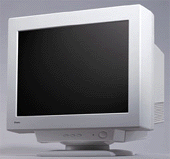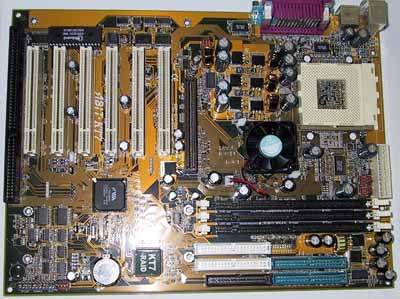Buyer's Guide: Value Systems - November 2000
by Mike Andrawes on November 25, 2000 3:06 PM EST- Posted in
- Guides
Value Professional 3D
Professional 3D users tend
to require higher-end components, so once again we got for most bang for the
buck, but with a little more flexibility as far as price goes. CPU performance
is critical and we need more RAM here than any other system we've looked at
previously. The graphics requirements are also very different in the professional
space and a large monitor is critical.
 Processor
– AMD Duron 800 - $120
Processor
– AMD Duron 800 - $120
As we proved in our Duron Review, the
800MHz part performs with the best of them when it comes to professional applications.
Whether you're building a cheap programming workstation or a sub $2000 OpenGL
powerhouse, the Duron is the perfect solution.
If you feel like overclocking, the Duron's that we've tested have run at 900 - 950 MHz by simply boosting the voltage and changing the clock multiplier. Of course, overclocking AMD's Socket-A CPU's, including the Duron, has been the center of much controversy, but it's quite easy with the right motherboard and the correct information. For full details on overclocking the Duron, read our AMD Thunderbird & Duron Overclocking Revealed Article and the "What to look for in a KT133 Motherboard" section of our Socket-A Motherboard Roundup for August 2000.
For more information on all Duron processors, read our AMD Duron review.
Motherboard – ABIT KT7
- $125
We recently looked at as many Socket-A
boards as we could get a hold of and one board stood out head and shoulders
above the rest - the ABIT KT7-RAID. While
that board is a bit expensive for a value system, ABIT still has a solution
for everyone, including the budget-conscious. By dropping the "RAID"
part of the product name, and the associated RAID features, the KT7 is available
for a much more reasonable $125. As we noted in the roundup, the KT7 is the
perfect board to overclock with thanks to its completely jumperless Soft Menu
III CPU setup.
The Asus A7V is also an excellent choice that also offers complete overclocking/multiplier control, albeit not in 100% jumperless form. The MSI K7T Pro2 should be hitting the streets soon as well, with new and improved overclocking options, including multiplier manipulation. We expect that the K7T Pro2 will probably become the motherboard of choice in the value systems since it will probably cost about $20-30 less than the ABIT KT7 or Asus A7V.One last option is the EPoX EP-8KTA2, which also offers all the overclocking features of the KT7 (not jumperless though), but also adds the VIA 686B south bridge that includes Ultra ATA 100 support.
For more information, read our ABIT KT7-RAID Review, Asus A7V Review, MSI K7T Pro2 Review, EPoX EP-8KTA2 Review and Socket-A KT133 Motherboard Roundup.
Memory – 256MB Nanya
or Mushkin Budget PC133 SDRAM (2x128MB DIMM’s) – $160
SDRAM prices are
finally back on the way down and they sure are dropping fast! Last month the
Mushkin Budget memory that we're recommending here was $140, but has dropped
almost 50% to $80 now.
Mushkin Budget
PC133 w/ Nanya chips

Click to Enlarge
While we can't point you in the direction of our usual recommendation of 128MB Corsair PC133 SDRAM due to cost, Mushkin's Budget PC133 SDRAM which we included in our latest PC133 SDRAM Roundup actually makes use of NANYA SDRAM chips which happened to work fairly well as you can see from our roundup.
Since we couldn't find any 256MB modules with the affordable NANYA chips we decided to simply recommend using two 128MB modules. If you think you'll need significantly more memory in the future, consider paying the extra money necessary to get a single 256MB stick.
Video card – NVIDIA GeForce2
MX - $110
This month, we've moved to an NVIDIA GeForce2 MX based card for our value
professional system. As far as T&L power goes, the GeForce2 MX provides
30% more T&L power than the original NVIDIA Quadro and is nearly as fast
as the GeForce2 GTS or Quadro2 Pro/MXR in applications that are not fillrate
limited.
On the overclocking side, the 0.18-micron core of the GeForce2 MX allows for considerable core overclocking, even without a heatsink. However, memory bandwidth is where the bottleneck is, and thus overclocking the memory is the most efficient way to boost the performance of these cards. Read our GeForce2 MX Overclocking Guide for all the details.
GeForce2 MX cards are still just showing up on the market, so we can't recommend any particular model just yet. We've seen prices in the $110 range, with a few vendors dipping as low as $95 on some models. Note that a few GeForce2 MX's are available for even less, but with just 16MB of RAM. With the relatively small price differential, it's simply not worth cutting the memory in half at this point in time.
For more information, see our NVIDIA GeForce2 MX Review.
 Monitor
– iiYama VisionMaster PRO 450 - $650
Monitor
– iiYama VisionMaster PRO 450 - $650
Using a Mitsubishi Diamondtron NF, the iiYama VisionMaster Pro 450 provides
a perfectly flat display surface using the same technology in Sony’s FD Trinitron
models, but at a lower cost. Make sure you can deal with the damper wires that
all Trinitron style tubes have. The VisionMaster PRO 450 is a 19” monitor and
it is highly recommended by us at AnandTech and owners alike. If you’ve got
the funds, we highly recommend you go with the 22” VisionMaster PRO 510 for
about $1000.
For more information, read our iiYama VisionMaster PRO 450 and VisionMaster PRO 510 Reviews.











0 Comments
View All Comments